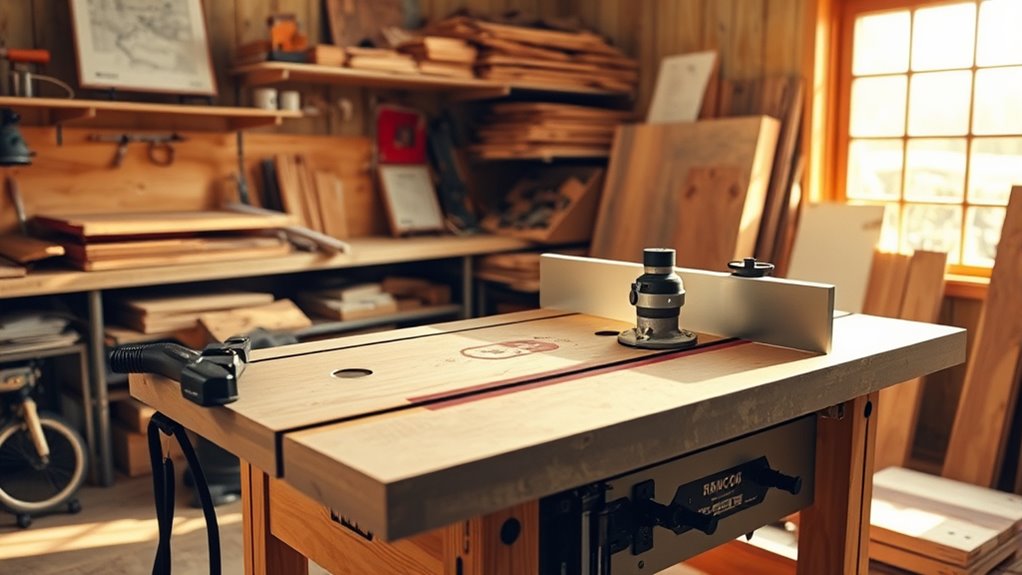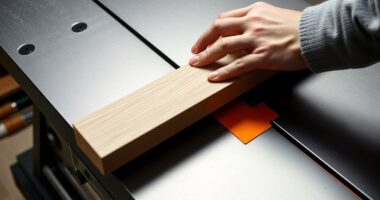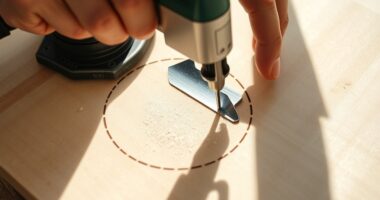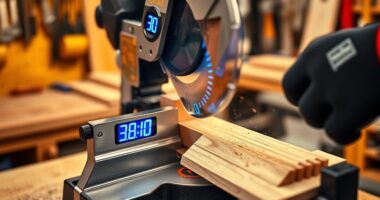To master the router table in a weekend, focus on safety first—secure all guards, wear protective gear, and keep hands clear. Learn to adjust the fence and bit height accurately, then practice feeding material slowly and steadily against the bit’s rotation. Use feather boards and push sticks for control, and practice different cuts on scrap pieces to build confidence. By carefully developing your skills and following safety protocols, you’ll build a solid foundation for precise, professional results. Keep going for more detailed tips.
Key Takeaways
- Start with safety: secure all guards, wear protective gear, and unplug the router when adjusting settings.
- Practice proper biting techniques on scrap material to develop feel and control.
- Adjust the fence accurately parallel to the bit and set the correct bit height for each cut.
- Use feather boards or push sticks to maintain control and prevent accidents during routing.
- Progress gradually through different techniques, focusing on consistency and precision to build confidence.
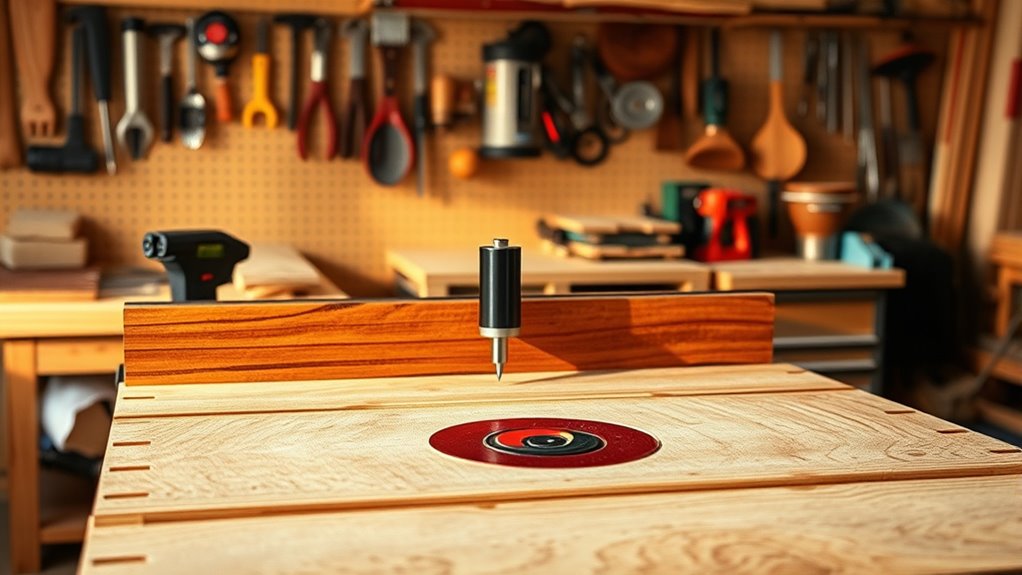
Have you ever wondered how to achieve perfectly smooth and precise cuts in your woodworking projects? Mastering your router table is the key, and dedicating a weekend to it can dramatically improve your craftsmanship. To start, understanding the importance of biting techniques is essential. Biting techniques refer to how you feed material into the router bit, influencing the quality of your cut and the safety of your operation. Always feed your work slowly and steadily, against the rotation of the bit, to ensure clean cuts and prevent kickback. Practice on scrap pieces first, so you can get a feel for how much pressure to apply and how the material responds. Proper biting techniques not only improve your precision but also reduce strain on the machine and minimize the risk of accidents.
Master your router table with proper feeding techniques for cleaner cuts and safer operation.
Router table safety should be your top priority. Before even plugging in your tool, double-check that all parts are secure—bit guards, fences, and safety switches are in place and functioning properly. Always wear safety goggles and a dust mask, and avoid loose clothing that could get caught in the spinning bits. Keep your hands clear of the bit at all times, and never reach over a moving router. When making adjustments, turn off the machine and unplug it to prevent accidental startups. Familiarize yourself with the emergency stop button, so you can quickly shut down the router in case of an emergency.
Getting comfortable with your router table also involves understanding its features and controls. Adjust the fence accurately for each cut, making sure it’s locked tight and parallel to the bit. Use feather boards or push sticks when working with small or thin pieces—they help maintain control and keep your fingers safe. Take the time to set the correct bit height for each project; a proper height ensures cleaner cuts and less strain on the motor. Practice different routing techniques, such as edge profiling or grooves, on scrap pieces to build confidence and develop muscle memory. Additionally, understanding the importance of proper feed rate enhances cut quality and safety, ensuring smoother finishes and reducing the risk of tear-out.
Additionally, pay attention to dust collection. A well-ventilated workspace and an efficient dust extraction system keep the area clean and improve visibility, making your work safer and more enjoyable. As you spend your weekend practicing, focus on maintaining consistent biting techniques and enforcing safety protocols. With patience and attention to detail, you’ll find yourself gaining skill and confidence, transforming your router table from an intimidating tool into a precise, reliable asset in your woodworking arsenal. Soon enough, you’ll be creating professional-quality pieces with smooth edges and perfect joints, all thanks to your newfound mastery of the router table.
Frequently Asked Questions
How Do I Choose the Right Router Bit for Specific Cuts?
When choosing the right router bit for specific cuts, start with bit selection that matches your project needs. Consider the type of cut and material you’re working with, ensuring your bit is compatible and cut compatible. Pay attention to the profile and size of the bit, and always check for sharpness and quality. This way, you achieve clean, precise cuts while preventing damage to your workpiece or router.
What Safety Gear Should I Wear When Using the Router Table?
Think of safety gear as your armor against potential hazards. When using the router table, you should wear protective gear like safety glasses or goggles to shield your eyes from flying debris, ear protection to guard against loud noise, and a dust mask to prevent inhaling fine particles. Don’t forget to keep your hands clear of the cutting area and wear snug-fitting clothing to avoid entanglement. Safety equipment keeps you protected while you craft with confidence.
How Can I Correct Common Mistakes During Setup?
When correcting common setup mistakes, start by checking your dust collection system to make a clear workspace and visibility. Next, verify router alignment carefully, adjusting the bit height and fence for precision. Test on scrap material first, observing dust and cut quality. Regularly inspect your setup, and make small adjustments as needed. Proper dust collection and router alignment are key to safe, accurate, and efficient router table operation.
What Maintenance Is Required to Keep the Router Table in Top Condition?
You’ll find that regular maintenance keeps your router table in top shape, just like catching a coincidental breeze on a warm day. Keep an eye on router dust buildup and clean it often to prevent clogs. Check fence alignment frequently to guarantee precise cuts. Lubricate moving parts as needed, and inspect wiring for wear. Staying proactive with these tasks ensures your router table remains reliable and safe for all your woodworking projects.
Are There Advanced Techniques to Increase Precision and Speed?
To increase precision and speed on your router table, you should explore advanced jig techniques, like custom jigs for complex cuts, and use featherboards guides to hold workpieces securely. These tools help you make cleaner, more accurate cuts while reducing errors. Incorporate these methods into your routine, and you’ll find yourself working faster and more precisely, turning your router table into a highly efficient and professional-grade woodworking station.
Conclusion
By dedicating a weekend to mastering your router table, you’re opening the craftsmanship of a seasoned artisan, much like Da Vinci honing his skills. With patience and practice, you’ll transform raw wood into works of art, confident in your abilities. Remember, every expert was once a beginner who dared to learn. So, take these tips, trust your hands, and soon you’ll craft with the precision and finesse of a true master.
